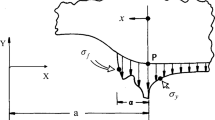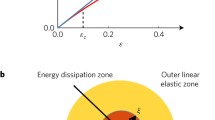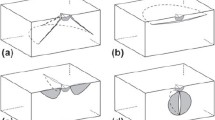Abstract
Fracture behaviors commonly found in hard plastics, glasses and metals with restricted plasticity are discussed relative to their force requirements. These are onset and arrest of rapid crack extension, the stable balance of crack speed against driving force of the running crack, the limiting crack speed and crack division. A method is given for calculating the stress-field driving forceG for closely and evenly spaced radial cracks. The Kerkhof ultrasonic-ripple-marking technique for determination of crack speed is discussed. These procedures are illustrated with experimental tests of crack division and crack arrest.
Similar content being viewed by others
Abbreviations
- G :
-
crack-extension force, lb/in
- K :
-
stress-intensity factor
- σ y :
-
extensional stress normal to plane of crack
- r, θ:
-
polar coordinates
- E :
-
Young's modulus
- ν:
-
Poisson's ratio
- L :
-
distance between parallel grips clamping brittle material
- s :
-
spacing between two cracks
- δU :
-
fixed-grip loss of strain energy when crack advances fromx=0 tox=α
- 2a :
-
length of central crack
- τ xy :
-
shear stress
- K t :
-
stress-concentration factor (Peterson)
- r :
-
root radius
- v L :
-
limiting crack speed
- D :
-
gross plate width
- d :
-
net plate width
- σ N :
-
stress on plate, psi
- c 2 :
-
elastic shear-wave velocity
References
Green, A. E., andSneddon, I. N., “The Distribution of Stress in the Neighborhood of a Flat Elliptical Crack in an Elastic Solid,”Proc. Cambridge Phil. Soc.,46,159 (1950).
Irwin, G. R., “Crack Extension-Force for a Part-Through Crack in a Plate,” Trans. ASME, 651 (1962).
Griffith, A. A., “The Phenomenon of Rupture and Flow in Solids,”Roy. Soc. (London), Phil. Trans. 221,163 (1920).
Irwin, G. R., “Analysis of Stresses and Strains Near the End of a Crack Traversing a Plate,”Inl. Appl. Mech.,24,361 (1957).
Inglis, C. E., “Stress in a Plate Due to the Pressure of Cracks and Sharp Corners,”Trans. Inst. Naval Arch.,60,219 (1913).
Paris, P. C., and Sih, G. C., “Stress Analysis of Cracks,” ASTM Symp. on Fracture Toughness, June 1964. ASTM-STP 381 (1965).
Yoffe, E. H., “The Moving Crack,”Phil. Mag. 42,739 (1951).
Irwin, G. R., “Relatively Unexplored Aspects of Fracture Mechanics,” Univ. of Ill., TAM Rpt. 204 (February 1963).
Post, D., “Photoelastic Stress Analysis for an Edge Crack in a Tensile Field,” SESA, XII (1), 99 (1954).
Irwin, G. R., “Fracture,” in Encyl. of Physics (Springer), VI, 551 (1958).
Smith, H. L., and Ferguson, W. J., “Crack Velocity Measurements in Cellulose Acetate,” Rpt. of NRL Progr. (April 1950).
Schardin, H., Elle, D., andStruth, W., “Uber den zeitlichen Ablauf des Bruchvorganges in Glas and Kungstglas,”Z. Tech. Physik,21,393 (1940).
Acloque, P., “High Speed Cinematographic Study of the Fracture Process in Toughened Glass (in French),” Symp. Sur la Resistance Mech. du Verre, Florence, 1961, Union Scient. Cont. du Verre, 886 (1962).
Peterson, R. E., “Stress Concentration Design Factors,”Wiley & Sons, New York, (1953).
Wells, A. A., andPost, D., “The Dynamic Stress Distribution Surrounding a Running Crack,”Discussion by G. R. Irwin, Proc. SESA, XVI (1),69 (1958).
Saibel, E., “Speed of Propagation of Fracture Cracks,”Fracturing of Metals (ASMS, Chicago, 1947), ASM, Cleveland (1948).
Kerkhof, F., “Neuere Ergebnisse der Ultraschall-Fractographic,” Symp. on Strength of Glass, Florence 1961-Union Scient. Continentale du Verre.
Kerkhof, F., “Analyse des Sproden Zugbruchs von Glasern mittles Ultraschall,”Naturw. 40, 478 (1953).
Irwin, G. R., “Structural Aspects of Brittle Fracture,”Appl. Matls Rsch. 3 (2),65 (1964).
Irwin, G. R., “Crack Toughness Testing of Strain Rate Sensitive Materials,”Trans. ASME,86,A,444 (1964).
Johnson, H. H., and Willner, A. M., “Moisture and Stable Crack Growth in a High Strength Steel,” Appl. Matls Rsch. (January 1965).
Author information
Authors and Affiliations
Rights and permissions
About this article
Cite this article
Clark, A.B.J., Irwin, G.R. Crack-propagation behaviors. Experimental Mechanics 6, 321–330 (1966). https://doi.org/10.1007/BF02327512
Issue Date:
DOI: https://doi.org/10.1007/BF02327512




